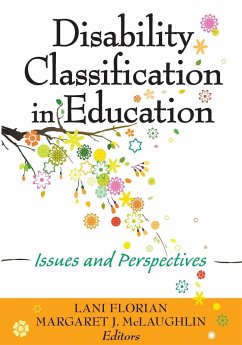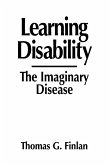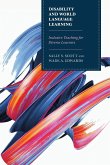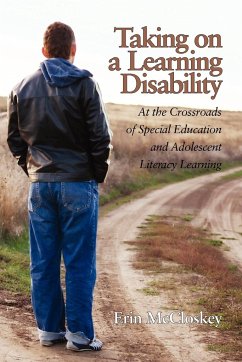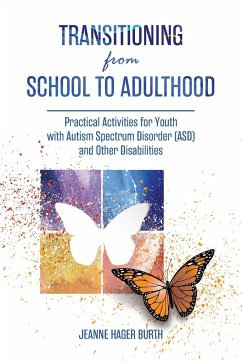- Broschiertes Buch
- Merkliste
- Auf die Merkliste
- Bewerten Bewerten
- Teilen
- Produkt teilen
- Produkterinnerung
- Produkterinnerung
This edited volume examines current disability classification systems, the dilemmas educators face in categorizing students with special needs, and alternative options based on recent challenges and trends.
Andere Kunden interessierten sich auch für
![Education of Students with an Intellectual Disability Education of Students with an Intellectual Disability]() Phil ForemanEducation of Students with an Intellectual Disability63,99 €
Phil ForemanEducation of Students with an Intellectual Disability63,99 €![Incidents In The Life Of A Blind Girl Incidents In The Life Of A Blind Girl]() Mary L. DayIncidents In The Life Of A Blind Girl30,99 €
Mary L. DayIncidents In The Life Of A Blind Girl30,99 €![Discrit--Disability Studies and Critical Race Theory in Education Discrit--Disability Studies and Critical Race Theory in Education]() Discrit--Disability Studies and Critical Race Theory in Education58,99 €
Discrit--Disability Studies and Critical Race Theory in Education58,99 €![Learning Disability Learning Disability]() Thomas G. FinlanLearning Disability42,99 €
Thomas G. FinlanLearning Disability42,99 €![Disability and World Language Learning Disability and World Language Learning]() Sally ScottDisability and World Language Learning44,99 €
Sally ScottDisability and World Language Learning44,99 €![Taking on a Learning Disability Taking on a Learning Disability]() Erin MccloskeyTaking on a Learning Disability64,99 €
Erin MccloskeyTaking on a Learning Disability64,99 €![Transitioning from School to Adulthood Transitioning from School to Adulthood]() Jeanne Hager BurthTransitioning from School to Adulthood43,99 €
Jeanne Hager BurthTransitioning from School to Adulthood43,99 €-
-
-
This edited volume examines current disability classification systems, the dilemmas educators face in categorizing students with special needs, and alternative options based on recent challenges and trends.
Hinweis: Dieser Artikel kann nur an eine deutsche Lieferadresse ausgeliefert werden.
Hinweis: Dieser Artikel kann nur an eine deutsche Lieferadresse ausgeliefert werden.
Produktdetails
- Produktdetails
- Verlag: Corwin
- Seitenzahl: 298
- Erscheinungstermin: 27. März 2008
- Englisch
- Abmessung: 254mm x 178mm x 16mm
- Gewicht: 565g
- ISBN-13: 9781412938778
- ISBN-10: 1412938775
- Artikelnr.: 23386622
- Herstellerkennzeichnung
- Libri GmbH
- Europaallee 1
- 36244 Bad Hersfeld
- gpsr@libri.de
- Verlag: Corwin
- Seitenzahl: 298
- Erscheinungstermin: 27. März 2008
- Englisch
- Abmessung: 254mm x 178mm x 16mm
- Gewicht: 565g
- ISBN-13: 9781412938778
- ISBN-10: 1412938775
- Artikelnr.: 23386622
- Herstellerkennzeichnung
- Libri GmbH
- Europaallee 1
- 36244 Bad Hersfeld
- gpsr@libri.de
Lani Florian is a Professor and Bell Chair of Education at the University of Edinburgh and Visiting Professor of Special Education at the University of Vienna. She is an Academician of the Academy of Social Sciences (UK). Her research interests include models of provision for meeting the needs of all learners, and inclusive pedagogy. She is co-author of Achievement and Inclusion in Schools, winner of the 2008 NASEN/Times Education Supplement academic book award. She has consulted on special needs education and inclusion for a number of international organisations including Open Society Foundations, UNICEF, and the OECD.
Preface
Acknowledgments
About the Authors
Part I. International and Cross-National Contexts Within the Current Use of
Disability Classification
1. Disability Classification in Education - Lani Florian, Margaret J.
McLaughlin
The Purpose of the Book
Structure of the Book
2. Cross-National Comparisons of Special Education Classification Systems -
Judith Hollenweger
Approaches to Develop Indicators Relevant to Special Needs Education
3. A Supply Side Approach for a Resource-Based Classification System -
Serge Ebersold, Peter Evans
A Resource-Based Approach From a Comparative Perspective
A Resource-Based Approach for Policy Monitoring
4. Evolving Dilemmas About Categorization - Klaus Wedell
Categorization in a Historical Perspective
Recent Conceptualizations of Categorization
5. Disability Classification, Categorization in Education: A US Perspective
- Philip J. Burke, Kristin Ruedel
Prior to 1975
The Hobbs Report
IDEA
6A. Implications for Human and Civil Rights Entitlements: Stigma,
Stereotypes, and Civil Rights in Disability Classification Systems - Diana
Pullin
Use of Classifications in Law
Diminishing Disability
6B. Implications for Human and Civil Rights Entitlements: Disability
Classification Systems and the Law of Special Education - Diana Pullin
Applying IDEA Classifications
IDEA and the No Child Left Behind Act
New Contexts for Classification
7. The Classification of Pupils at the Educational Margins in Scotland:
Shifting Categories and Frameworks - Sheila Riddell
SEN Policy Frameworks
Policy Frameworks and Classification Systems
Policy Outcomes: Special Education and the Classification of Children in
Scotland
The Impact of Disability Legislation in Scotland
The Education (Additional Support for Learning)(Scotland) Act 2004
Identifying Children With Additional Support Needs
Rights of Appeal, Adjudication, and Mediation
Inclusion and Additional Support for Learning
Part II. Interaction and Impacts of Classification Policies on Educational
Systems
8. Perspectives and Purposes of Disability Classification Systems:
Implications for Teachers and Curriculum and Pedagogy - Brahm Norwich
Different Kinds of Classifications
Are Categories of Disabilities and Difficulties Used in Special Education
Relevant to Teaching?
Implications for Classification of Special Educational Needs
Concluding Comments
9. Disability Classification and Teacher Education - Michael L. Hardman,
John McDonnell
Preparing Teachers by Disability Category
Beyond Disability Categories: Preparing All Teachers for a Standards-Driven
System
10. Disproportionality in Special Education: A Transatlantic Phenomenon -
Alan Dyson, Elizabeth Kozleski
Disproportionality in Special Education in the USA
Disproportionality in Special Education in England
Disproportionality in Two Countries
11. Classification of Children With Disabilities in the Context of
Performance-Based Educational Reform? An Unintended Classification System -
Katherine Nagle, Martha L. Thurlow
Background
Performance-Based Accountability: A New Classification System
Part III. New Approaches to the Classification Dilemma
12. International Classification of Functioning, Disability, and Health -
Rune J. Simeonsson, Nancy E. Simeonsson, Judith Hollenweger
Defining and Classifying Childhood Disability
Classification Problems in Education
The Dimensional Paradigm of Disability
Toward a Common Language of Disability in Special Education
13. Learning Disabilities in the United States: Operationalizing a
Construct - Deborah L. Speece
14. Beyond the Dilemma of Difference: The Capability Approach on Disability
and Special Educational Needs - Lorella Terzi
Conceptualizing Differences in Education: Disability and Special
Educational Needs
Reconceptualizing Disability: The Capability Approach
Beyond the Dilemma of Difference: The Capability Approach in Education
15. Concluding Thoughts: On Perspectives and Purposes of Disability
Classification Systems in Education - Martyn Rouse, Kelly Henderson, Lou
Danielson
References
Index
Acknowledgments
About the Authors
Part I. International and Cross-National Contexts Within the Current Use of
Disability Classification
1. Disability Classification in Education - Lani Florian, Margaret J.
McLaughlin
The Purpose of the Book
Structure of the Book
2. Cross-National Comparisons of Special Education Classification Systems -
Judith Hollenweger
Approaches to Develop Indicators Relevant to Special Needs Education
3. A Supply Side Approach for a Resource-Based Classification System -
Serge Ebersold, Peter Evans
A Resource-Based Approach From a Comparative Perspective
A Resource-Based Approach for Policy Monitoring
4. Evolving Dilemmas About Categorization - Klaus Wedell
Categorization in a Historical Perspective
Recent Conceptualizations of Categorization
5. Disability Classification, Categorization in Education: A US Perspective
- Philip J. Burke, Kristin Ruedel
Prior to 1975
The Hobbs Report
IDEA
6A. Implications for Human and Civil Rights Entitlements: Stigma,
Stereotypes, and Civil Rights in Disability Classification Systems - Diana
Pullin
Use of Classifications in Law
Diminishing Disability
6B. Implications for Human and Civil Rights Entitlements: Disability
Classification Systems and the Law of Special Education - Diana Pullin
Applying IDEA Classifications
IDEA and the No Child Left Behind Act
New Contexts for Classification
7. The Classification of Pupils at the Educational Margins in Scotland:
Shifting Categories and Frameworks - Sheila Riddell
SEN Policy Frameworks
Policy Frameworks and Classification Systems
Policy Outcomes: Special Education and the Classification of Children in
Scotland
The Impact of Disability Legislation in Scotland
The Education (Additional Support for Learning)(Scotland) Act 2004
Identifying Children With Additional Support Needs
Rights of Appeal, Adjudication, and Mediation
Inclusion and Additional Support for Learning
Part II. Interaction and Impacts of Classification Policies on Educational
Systems
8. Perspectives and Purposes of Disability Classification Systems:
Implications for Teachers and Curriculum and Pedagogy - Brahm Norwich
Different Kinds of Classifications
Are Categories of Disabilities and Difficulties Used in Special Education
Relevant to Teaching?
Implications for Classification of Special Educational Needs
Concluding Comments
9. Disability Classification and Teacher Education - Michael L. Hardman,
John McDonnell
Preparing Teachers by Disability Category
Beyond Disability Categories: Preparing All Teachers for a Standards-Driven
System
10. Disproportionality in Special Education: A Transatlantic Phenomenon -
Alan Dyson, Elizabeth Kozleski
Disproportionality in Special Education in the USA
Disproportionality in Special Education in England
Disproportionality in Two Countries
11. Classification of Children With Disabilities in the Context of
Performance-Based Educational Reform? An Unintended Classification System -
Katherine Nagle, Martha L. Thurlow
Background
Performance-Based Accountability: A New Classification System
Part III. New Approaches to the Classification Dilemma
12. International Classification of Functioning, Disability, and Health -
Rune J. Simeonsson, Nancy E. Simeonsson, Judith Hollenweger
Defining and Classifying Childhood Disability
Classification Problems in Education
The Dimensional Paradigm of Disability
Toward a Common Language of Disability in Special Education
13. Learning Disabilities in the United States: Operationalizing a
Construct - Deborah L. Speece
14. Beyond the Dilemma of Difference: The Capability Approach on Disability
and Special Educational Needs - Lorella Terzi
Conceptualizing Differences in Education: Disability and Special
Educational Needs
Reconceptualizing Disability: The Capability Approach
Beyond the Dilemma of Difference: The Capability Approach in Education
15. Concluding Thoughts: On Perspectives and Purposes of Disability
Classification Systems in Education - Martyn Rouse, Kelly Henderson, Lou
Danielson
References
Index
Preface
Acknowledgments
About the Authors
Part I. International and Cross-National Contexts Within the Current Use of
Disability Classification
1. Disability Classification in Education - Lani Florian, Margaret J.
McLaughlin
The Purpose of the Book
Structure of the Book
2. Cross-National Comparisons of Special Education Classification Systems -
Judith Hollenweger
Approaches to Develop Indicators Relevant to Special Needs Education
3. A Supply Side Approach for a Resource-Based Classification System -
Serge Ebersold, Peter Evans
A Resource-Based Approach From a Comparative Perspective
A Resource-Based Approach for Policy Monitoring
4. Evolving Dilemmas About Categorization - Klaus Wedell
Categorization in a Historical Perspective
Recent Conceptualizations of Categorization
5. Disability Classification, Categorization in Education: A US Perspective
- Philip J. Burke, Kristin Ruedel
Prior to 1975
The Hobbs Report
IDEA
6A. Implications for Human and Civil Rights Entitlements: Stigma,
Stereotypes, and Civil Rights in Disability Classification Systems - Diana
Pullin
Use of Classifications in Law
Diminishing Disability
6B. Implications for Human and Civil Rights Entitlements: Disability
Classification Systems and the Law of Special Education - Diana Pullin
Applying IDEA Classifications
IDEA and the No Child Left Behind Act
New Contexts for Classification
7. The Classification of Pupils at the Educational Margins in Scotland:
Shifting Categories and Frameworks - Sheila Riddell
SEN Policy Frameworks
Policy Frameworks and Classification Systems
Policy Outcomes: Special Education and the Classification of Children in
Scotland
The Impact of Disability Legislation in Scotland
The Education (Additional Support for Learning)(Scotland) Act 2004
Identifying Children With Additional Support Needs
Rights of Appeal, Adjudication, and Mediation
Inclusion and Additional Support for Learning
Part II. Interaction and Impacts of Classification Policies on Educational
Systems
8. Perspectives and Purposes of Disability Classification Systems:
Implications for Teachers and Curriculum and Pedagogy - Brahm Norwich
Different Kinds of Classifications
Are Categories of Disabilities and Difficulties Used in Special Education
Relevant to Teaching?
Implications for Classification of Special Educational Needs
Concluding Comments
9. Disability Classification and Teacher Education - Michael L. Hardman,
John McDonnell
Preparing Teachers by Disability Category
Beyond Disability Categories: Preparing All Teachers for a Standards-Driven
System
10. Disproportionality in Special Education: A Transatlantic Phenomenon -
Alan Dyson, Elizabeth Kozleski
Disproportionality in Special Education in the USA
Disproportionality in Special Education in England
Disproportionality in Two Countries
11. Classification of Children With Disabilities in the Context of
Performance-Based Educational Reform? An Unintended Classification System -
Katherine Nagle, Martha L. Thurlow
Background
Performance-Based Accountability: A New Classification System
Part III. New Approaches to the Classification Dilemma
12. International Classification of Functioning, Disability, and Health -
Rune J. Simeonsson, Nancy E. Simeonsson, Judith Hollenweger
Defining and Classifying Childhood Disability
Classification Problems in Education
The Dimensional Paradigm of Disability
Toward a Common Language of Disability in Special Education
13. Learning Disabilities in the United States: Operationalizing a
Construct - Deborah L. Speece
14. Beyond the Dilemma of Difference: The Capability Approach on Disability
and Special Educational Needs - Lorella Terzi
Conceptualizing Differences in Education: Disability and Special
Educational Needs
Reconceptualizing Disability: The Capability Approach
Beyond the Dilemma of Difference: The Capability Approach in Education
15. Concluding Thoughts: On Perspectives and Purposes of Disability
Classification Systems in Education - Martyn Rouse, Kelly Henderson, Lou
Danielson
References
Index
Acknowledgments
About the Authors
Part I. International and Cross-National Contexts Within the Current Use of
Disability Classification
1. Disability Classification in Education - Lani Florian, Margaret J.
McLaughlin
The Purpose of the Book
Structure of the Book
2. Cross-National Comparisons of Special Education Classification Systems -
Judith Hollenweger
Approaches to Develop Indicators Relevant to Special Needs Education
3. A Supply Side Approach for a Resource-Based Classification System -
Serge Ebersold, Peter Evans
A Resource-Based Approach From a Comparative Perspective
A Resource-Based Approach for Policy Monitoring
4. Evolving Dilemmas About Categorization - Klaus Wedell
Categorization in a Historical Perspective
Recent Conceptualizations of Categorization
5. Disability Classification, Categorization in Education: A US Perspective
- Philip J. Burke, Kristin Ruedel
Prior to 1975
The Hobbs Report
IDEA
6A. Implications for Human and Civil Rights Entitlements: Stigma,
Stereotypes, and Civil Rights in Disability Classification Systems - Diana
Pullin
Use of Classifications in Law
Diminishing Disability
6B. Implications for Human and Civil Rights Entitlements: Disability
Classification Systems and the Law of Special Education - Diana Pullin
Applying IDEA Classifications
IDEA and the No Child Left Behind Act
New Contexts for Classification
7. The Classification of Pupils at the Educational Margins in Scotland:
Shifting Categories and Frameworks - Sheila Riddell
SEN Policy Frameworks
Policy Frameworks and Classification Systems
Policy Outcomes: Special Education and the Classification of Children in
Scotland
The Impact of Disability Legislation in Scotland
The Education (Additional Support for Learning)(Scotland) Act 2004
Identifying Children With Additional Support Needs
Rights of Appeal, Adjudication, and Mediation
Inclusion and Additional Support for Learning
Part II. Interaction and Impacts of Classification Policies on Educational
Systems
8. Perspectives and Purposes of Disability Classification Systems:
Implications for Teachers and Curriculum and Pedagogy - Brahm Norwich
Different Kinds of Classifications
Are Categories of Disabilities and Difficulties Used in Special Education
Relevant to Teaching?
Implications for Classification of Special Educational Needs
Concluding Comments
9. Disability Classification and Teacher Education - Michael L. Hardman,
John McDonnell
Preparing Teachers by Disability Category
Beyond Disability Categories: Preparing All Teachers for a Standards-Driven
System
10. Disproportionality in Special Education: A Transatlantic Phenomenon -
Alan Dyson, Elizabeth Kozleski
Disproportionality in Special Education in the USA
Disproportionality in Special Education in England
Disproportionality in Two Countries
11. Classification of Children With Disabilities in the Context of
Performance-Based Educational Reform? An Unintended Classification System -
Katherine Nagle, Martha L. Thurlow
Background
Performance-Based Accountability: A New Classification System
Part III. New Approaches to the Classification Dilemma
12. International Classification of Functioning, Disability, and Health -
Rune J. Simeonsson, Nancy E. Simeonsson, Judith Hollenweger
Defining and Classifying Childhood Disability
Classification Problems in Education
The Dimensional Paradigm of Disability
Toward a Common Language of Disability in Special Education
13. Learning Disabilities in the United States: Operationalizing a
Construct - Deborah L. Speece
14. Beyond the Dilemma of Difference: The Capability Approach on Disability
and Special Educational Needs - Lorella Terzi
Conceptualizing Differences in Education: Disability and Special
Educational Needs
Reconceptualizing Disability: The Capability Approach
Beyond the Dilemma of Difference: The Capability Approach in Education
15. Concluding Thoughts: On Perspectives and Purposes of Disability
Classification Systems in Education - Martyn Rouse, Kelly Henderson, Lou
Danielson
References
Index

